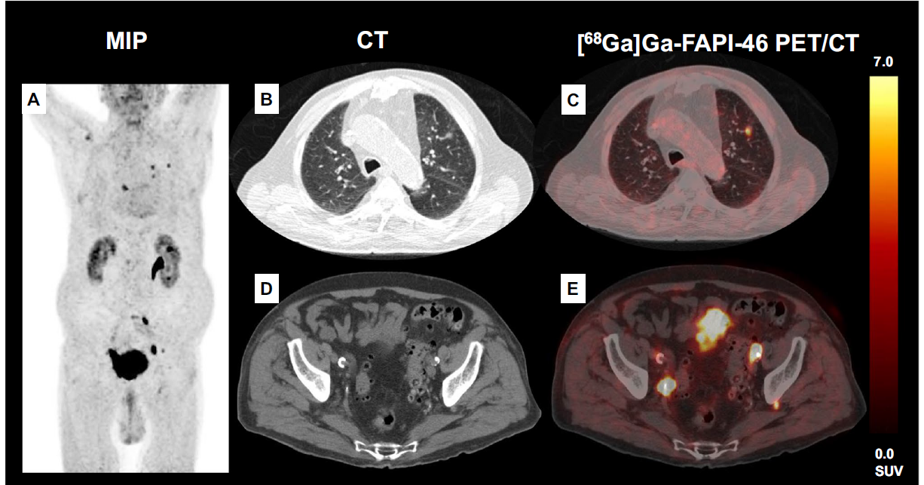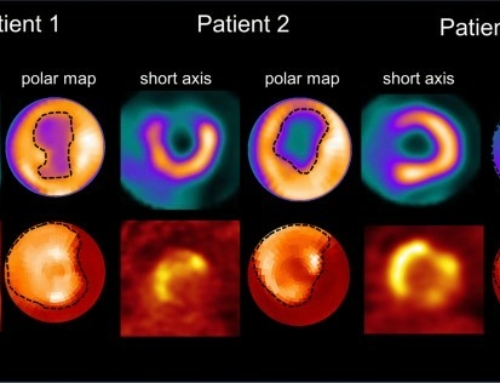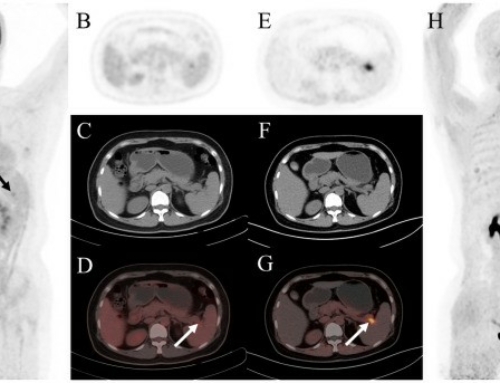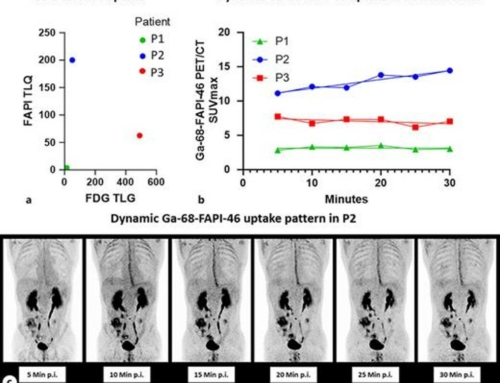Lena M Unterrainer, Simon Lindner, Lennert Eismann, Jozefina Casuscelli, Franz-Josef Gildehaus, Vinh Ngoc Bui, Nathalie L Albert, Adrien Holzgreve, Leonie Beyer, Andrei Todica, Matthias Brendel, Clemens C Cyran, Alexander Karl, Christian G Stief, Stephan T Ledderose, Marcus Unterrainer, Peter Bartenstein, Vera Wenter, Alexander Kretschmer
Background: [68Ga]Ga-FAPI-46 is a novel positron emission tomography (PET) ligand that targets fibroblast activation protein (FAP) expression as FAP inhibitor (FAPI) and could already show promising results in several tumor entities. It could be demonstrated that an increased FAP expression correlates with tumor aggressivity in urothelial carcinoma (UC). Given the limited value of [18F]FDG in UC, [68Ga]Ga-FAPI-46 could add diagnostic information in staging and response assessment in UC. We present the first data of [68Ga]Ga-FAPI-46 PET imaging in a pilot cohort of UC patients evaluating uptake characteristics in metastases and primary tumors.
Methods: Fifteen patients with UC prior to or after local treatment underwent [68Ga]Ga-FAPI-46 PET/CT imaging for detection of metastatic spread. We compared the biodistribution in non-affected organs and tumor uptake of UC lesions by standard uptake value measurements (SUVmean and SUVmax). Additionally, metastatic sites on PET were compared to its morphological correlate on contrast-enhanced computed tomography (CT).
Results: Overall, 64 tumor sites were detected on PET and/or CT. The highest uptake intensity was noted at the primary site (SUVmax 20.8 (range, 8.1-27.8)) followed by lymph node metastases (SUVmax 10.6 (range, 4.7-29.1)). In 4/15 (26.7%) patients there were [68Ga]Ga-FAPI-46-positive lesions that were missed on standard routine CT imaging. On the other hand, 2/15 patients had suspicious prominent bipulmonary nodules as well as pelvic lymph nodes previously rated as suspicious for metastatic spread on CT, but without increased FAPI expression; here histopathology excluded malignancy.
Conclusion: [68Ga]Ga-FAPI-46 PET shows distinctly elevated uptake in UC lesions. Therefore, the tracer has potential as a promising new biomarker in metastatic UC patients, as [68Ga]Ga-FAPI-46 PET might improve detection of metastatic sites compared to CT alone. These findings highly emphasize larger studies investigating FAPI imaging in UC patients.


![Efficacy of [68Ga]Ga-FAPI-PET as a non-invasive evaluation method of liver fibrosis](https://sofie.com/wp-content/uploads/2025/06/info.ibamolecular-500x383.png)
![Comparison of [99mTc]Tc-FAPI SPECT/CT and [18F]FDG PET/CT as predictive biomarkers for immunotherapy response in gastrointestinal cancer](https://sofie.com/wp-content/uploads/2025/06/info.ibamolecular-500x383.jpg)


